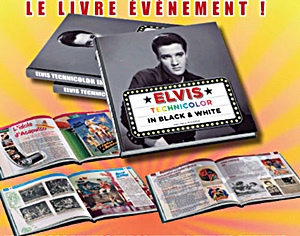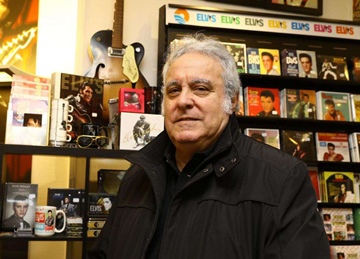 |
 |

Book Review: Elvis My Happiness, EC, 2020, Hardcover, 294 pages, Illustrated, Bonus 10” LP and CD, ISBN-13: 978-295671261 Reviewed by Nigel Patterson, December 2020 Elvis didn’t incarnate almost supernatural heroes, he was you and he was all of us. He played an everyday guy, an ordinary character with a job....(Jean-Marie Pouzenc) Jean-Marie Pouzenc, the founding president of the long running French fan club, Elvis My Happiness, has been writing high quality Elvis books for more than two decades. His latest deluxe coffee table release, Elvis Technicolor in Black & White, focusing on Elvis’ film career in France, does not disappoint. He is to be congratulated on his considered, informative and interesting narrative. The Narrative: The first thing to note is that the text is bi-lingual – French and English, giving the book a wider appeal. The English language translation was done by Martin Davies and he has done a great job. Generally, the respective texts are presented on a mirroring page format. Each of the entries includes a film synopsis, production details, and reviews from the time.
In framing Elvis’ film career, Jean-Marie defers to author, W.A. Harbinson, who wrote in his book, Elvis An Illustrated Biography:
Regarding Elvis’ film career in France, Jean-Marie’s comments are incisive:
Throughout the book, there is plenty to discover and learn. Interesting, often obscure, stories are found on each page:
We also learn of what appears to be an interesting 17 minute French documentary, Elvis Presley au cinema released in 2018 and produced by Jean-Luc Legier and Stephane Michaux. It is also likely that until Elvis Technicolor in Black & White, most non-French fans had not come across the Elvis film, Strip-Teaseuse Effarouchee (aka Girl Happy). Other French titles for Elvis’ films are similarly interesting, for instance L’Amour en Quatrieme Vitesse (Viva Las Vegas), Une Rousee qui Porte Bonheur (Frankie and Johnny), 3 Gars, 2 Filles et...1 Treor (Easy Come, Easy Go) and A Plein Tube (Speedway). Some titles are easier to work out, particularly Parais Hawaien and the most obvious one, Charro! Also, who knew that the French movie DSS 117 (released in 2009) included a tribute to Fun in Acapulco and used images from that film? And hands up those who know who dubbed Elvis’ voice in the French language versions of his films. The answer is Michael Roux, and the author devotes a page to his interesting career.
The author’s thoughtful approach to his work is further evidenced in his consideration of Elvis reinventing his film career. He appropriately posits:
The Visuals: Elvis Technicolor in Black & White features more than 1,000 images including several hundred rare or previously unpublished photos. There are also rare and interesting archival documents (posters, magazine and record covers, press ads, etc). They are quality images and blend well with the text to create a visually appealing look. Whether it is stills from the movie, publicity images or Elvis relaxing on the set between takes, the visuals please. The many highlights include:
The last 12 pages of the book offer a wonderful collection of full color and intriguing Elvis film posters from Belgium with French, and one Flemish, titles. With names such as Le Cavalier du Crepsucule (Love Me Tender), Le Rock du Bagne (Jailhouse Rock), L'amour en Quatrième Vitesse (Viva Las Vegas) and Mic-Mac au Montana (Stay Away, Joe), they make for great viewing.
Unlike some Elvis books, which involve countless pages of repetitive images, Elvis Technicolor in Black & White offers the reader something new and interesting on each page. Design: The sturdy hardback contains tightly bound quality gloss paper stock. The page design is strong, with good use of white space allowing both the narrative and visual elements to shine. The font size is easy on the eye and the images well placed. Bonus extras: A 10” LP (securely housed in a pocket in the inside front cover) features eight eclectic tracks from We’re Gonna Move (from Love Me Tender) to King of the Whole Wide World (Kid Galahad). For vinyl collectors this is a real treat. The CD (inside back cover) offers an aurally pleasing selection of 29 film tracks (alternate takes 1956 to 1963) including Jailhouse Rock, Don’t Leave Me Now, King Creole, Black Star, Beach Boy Blues, Can’t Help Falling in Love (Blue Hawaii), Summer Kisses Winter Tears, Girls! Girls! Girls!, and the underrated Lonely Man (cut from Wild In the Country). There are also two “bonus” tracks....”solo” recordings of Let Me and Summer Kisses, Winter Tears. Verdict: With its attractive design, thoughtful narrative and strong visual and aural elements, Elvis Technicolor in Black & White offers a wonderful reflection and important record of Elvis’ film career in France. It is a high quality release fans will appreciate - one that you will revisit time and time again.
Book Review by Nigel Patterson. Order Elvis Technicolor in Black & White See below for EIN's exclusive interview with Jean-Marie Pouzenc,
|
|








